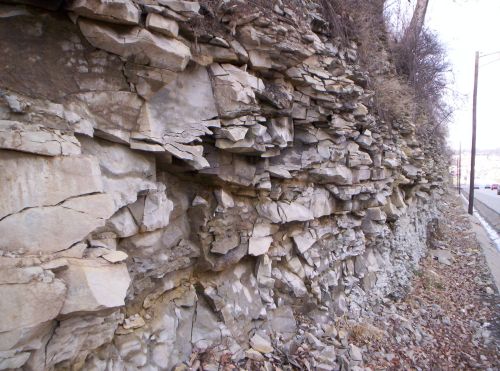This is my first Earthcache, which will take you to a
spectacularly deep cut through which a highway runs. The cut
exposes a portion of the world famous Wabash Reef, which originated
in the Silurian age 400 million years ago. Geologists study these
types of Limestone cuts, as well as the walls of quarries to learn
about our geological past.

Limestone
Cliffs
Limestone is a sedimentary rock composed
largely of the mineral calcite (calcium carbonate: CaCO3).
Limestones often contain variable amounts of silica in the form of
chert or flint, as well as varying amounts of clay, silt and sand
as disseminations, nodules, or layers within the rock.
The primary source of the calcite in limestone is most commonly
marine organisms. These organisms secrete shells that settle out of
the water column and are deposited on ocean floors as pelagic ooze
or alternatively is conglomerated in a coral reef, like at this
site. Limestone makes up about 10% of the total volume of all
sedimentary rocks.
Pure limestones are white or almost white.
Because of impurities, such as clay, sand, organic remains, iron
oxide and other materials, many limestones exhibit different
colors, especially on weathered surfaces. Limestone may be
crystalline, clastic, granular, or massive, depending on the method
of formation. Crystals of calcite, quartz, dolomite or barite may
line small cavities in the rock
During regional metamorphism that occurs
during the mountain building process (orogeny) limestone
recrystallizes into marble.
Limestone is especially popular in
architecture, and many landmarks around the world, especially in
North America and Europe, are made primarily of the material. So
many buildings in Kingston, Ontario, Canada were constructed from
it, that it was nicknamed the 'Limestone City'. Locally,
Huntington, Indiana is known as the "Lime City." Limestone is
readily available and relatively easy to cut into blocks or more
elaborate carving. It is also long-lasting and stands up well to
exposure. However, it is a very heavy material, making it
impractical for tall buildings. It is also quite expensive. It was
used locally for some of the culverts and lockes on the Wabash
& Erie Canal.
Limestone was most popular in the early 20th and late 19th
centuries. Train stations, banks and other structures from that era
are normally made of limestone. Limestone is used as a facade on
some skyscrapers, but only in thin plates for covering rather than
solid blocks. In the United States, Indiana, most notably the
Bloomington area, has long been a source of high quality quarried
limestone, called Indiana limestone.
Other uses include the manufacture of quicklime, cement and
mortor, road bed aggregate, and toothpaste!
To get credit for this cache you MUST:
1. Do the picture thing. Post a Picture of yourself with your
GPS with the site in background.
2. E-mail me with what the
local residents call this site (ask a resident of wabash i.e. at
Speedway or elsewhere)and your estimate of the height of the
biggest cliff.
(NOTE)If there is a question about the picture thing the proper
way is as the following cachers listed Panther in the Den, Master
of My Domain, and Lead Dog. I will NOT EXCEPT that it is unsafe or
no where to stand these are just a few of the cachers that done
this cache and done it right.
